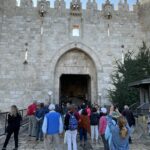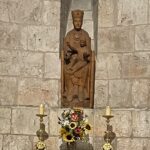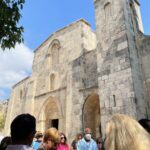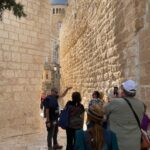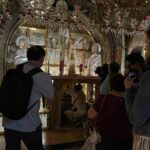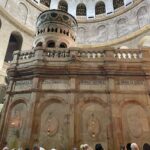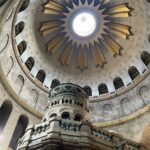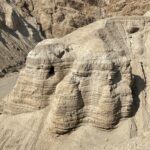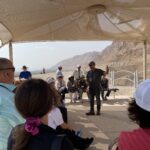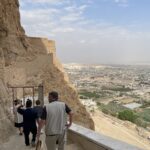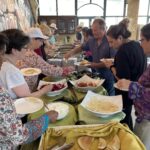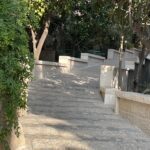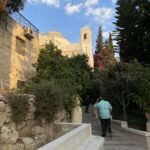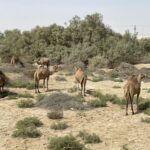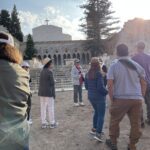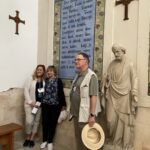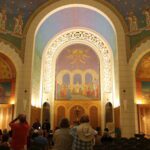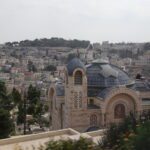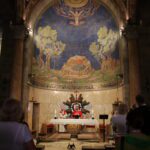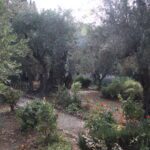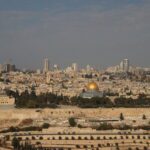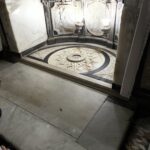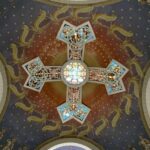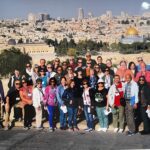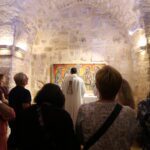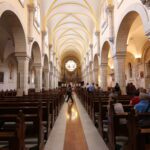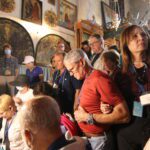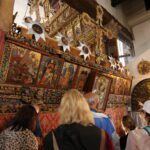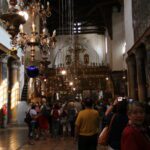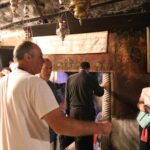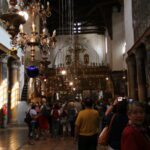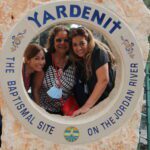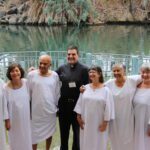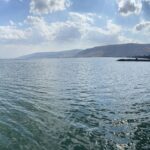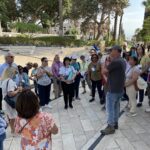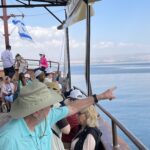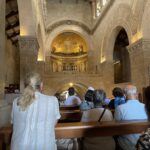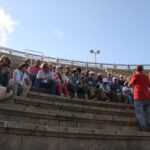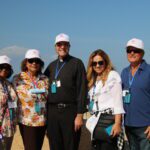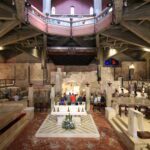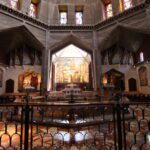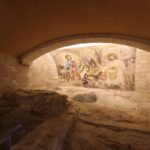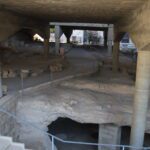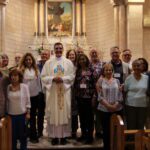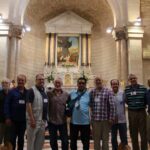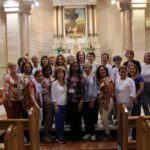The pilgrims’ final day was spent in the old city of Jerusalem. We began by entering the city through the Damascus Gate and making our way along narrow streets lined with shops to the Church of the Holy Sepulchre. We quickly got in line to wait our turn to enter the Tomb of Christ from which the Lord Jesus Christ rose from the dead on Easter Sunday. It was a deeply spiritual event for everyone. We then visited the site of Golgotha, located within the same church. We venerated the distinct places which mark where the Lord was stripped of his clothes, nailed to the cross, and the place of his suffering and death on the cross. We were then privileged to celebrate Mass at a chapel near the Tomb of Christ. Following Mass, we again walked through the old city, which now was packed with tourists and the residents of Jerusalem, and made our way to the Pool of Bethesda. We read from the Gospel where Jesus healed a lame man here who had waited 38 to be healed (John 5: 1-18). Nearby is the Church of Saint Anne and the birthplace of the Blessed Virgin Mary. The church was built by the Crusaders is one of only a few churches of that time which have survived. The pilgrims stood at the steps of the altar and sang “Hail, Holy Queen” and “Salve Regina” in honor of the Blessed Virgin Mary. From here we walked most of the Via Dolorosa (the Way of the Cross) and prayed the Stations of the Cross. Much as it would have been on Good Friday, the streets were crowded, noisy and chaotic. Following lunch, we made our way to the Church of the Dormition, where Our Lady was assumed into heaven. Unfortunately, it was closed for renovations. (Yet another reason to return someday.) We next visited the nearby site of the Last Supper (Cenaculum, in Latin) which also was the site of Pentecost. Finally, we made our way to the “Western Wall” (also known as the “Wailing Wall”). Our guide clarified that the wall is not a wall of the (Second) Temple, but rather a retaining wall that was the foundation of the Temple. Regardless, it remains the most sacred site for the Jewish people today. We were able to approach the wall – men (with a head covering) on one side and women on the other – to pray and, as is customary, insert within the cracks of the wall a paper with our special intentions. The evening ended with a delicious dinner at a local restaurant. We all expressed our sincere gratitude to Aehab our guide and Wahib our driver, both of whom did a wonderful job. This was the last event of the pilgrimage. While most of the pilgrims will be returning home on Tuesday, a group will be going on to Jordan. We all had a wonderful time walking this journey of faith and in fellowship with one another.
Author: Ashley Witherow
Day 5: Sunday
Sunday, the Day of the Lord, began with the pilgrims visiting Bethany, the town of Lazarus, Martha and Mary, and with the celebration of Holy Mass. We then visited the tomb of Lazarus whom Our Lord raised from the dead (cf. John 11: 38-53). The tomb is below ground and very small; accommodating only about four people at a time. Following this, we headed south toward Jericho. During the ride, we read the parable of the Good Samaritan (Luke 10: 29-37), which Our Lord set along this road. Soon we had arrived at Qumran near the Dead Sea, approximately 1,300 feet below sea level. We were able to visit the excavations of the Essenes, an all-male Jewish community who lived an ascetic life in the Judean dessert (ca. 200 BC – 100 AD). Perhaps most importantly, we learned the details of the accidental discovery in 1946 of the first of the Dead Sea scrolls in a nearby cave by a Bedouin shepherd boy. These scrolls (eventually numbering more than 900) include the oldest complete written text of the Book of the Prophet Isaiah, commentaries on several other books of the Old Testament, and writings on the daily life and religious practices of the Essenes. We then drove a short distance to the Dead Sea where several of the pilgrims swam (actually floated) in the water. After a quick shower, we made our way to Jericho, the oldest city in the word. We took a cable car and then climbed 90 steep steps to the top of the Mount of Temptation where a Greek Monastery is located. It is here that Jesus spent forty days in prayer and fasting in the desert (Matthew 4: 1-11), following his baptism by his cousin John the Baptist in the nearby Jordan River. Within the monastery, we were able to pray at the rock where tradition says Jesus was tempted by the devil. Following a quick stop by the sycamore tree of Zacchaeus (Luke 19: 1-10) and some souvenir shopping, our long and eventful day came to an end as we returned to Jerusalem and enjoyed one another’s company at dinner. Tomorrow, our last full day in the Holy Land, will be spent in the old city of Jerusalem.
Day 4: Saturday
Saturday morning found the pilgrims atop the Mount of Olives to take in a view of the old city of Jerusalem. After a group picture, we began our decent down the mountain until we arrived at the Church of Dominus Flavit (the Lord wept). Here, the Gospel tells us, the Lord Jesus wept over the city of Jerusalem, lamenting the refusal of its inhabitants to accept him, the long-promised Messiah (Luke 19:41-44). We continued on to the Garden of Gethsemane where, accompanied by Peter, James, and John, the Lord prayed most fervently to the Father regarding his upcoming passion. A few of the olive trees in the garden are 2,000 years old and witnessed Christ’s agony there. We then went to the Church of Saint Peter in Gallicantu which commemorates when Peter denied Our Lord three times. Beneath the church is the cave where Jesus was imprisoned overnight at the directive of the high priest Ciaphas. After reading Psalm 88, the pilgrims spent some time in silent prayer and reflection, with a sense of solidarity with the suffering Christ and in penitential sorrow for our sins. We then returned to Bethlehem and, following lunch, went to Shepherds’ Field, where the angles announced the birth of Christ to the shepherds on Christmas night. By late afternoon we were visiting En Karen, the birthplace of Saint John the Baptist and the place of the Visitation of Mary with her cousin Elizabeth. Mass was offered in the Church of St. John the Baptist. The day ended with our first entry into the old city of Jerusalem via the Jaffa Gate, a light show at the Tower of David, and a tour of Jerusalem by night. Tomorrow will bring more adventures and more memories.
Day 3: Friday
Friday was a transition day, from the Galilee (in northern Israel) to Jerusalem. We began the day at the River Jordan where Msgr. Souckar led all the pilgrims in the renewal of their baptismal promises and some entered the river itself. We then traveled south for a couple of hours, following the Jordan River which also is the border between Israel and Jordan. The geography changed dramatically from the relatively green and vibrant Galilee to an arid desert. Along the way, we saw several groupings of Bedouin, many of whom are shepherds and still live as they did the the the time of the Lord. By the afternoon we were in Bethlehem. At the Church of the Nativity we venerated the spot where Jesus Christ was born and the place of the manger. Mass was celebrated in the chapel of Saint Jerome who lived for many years in Bethlehem as he translated the Sacred Scriptures into Latin and where he died in 420. Finally, as the sun was setting and the Sabbath (Shabbat) was beginning for the Jewish people, we arrived at the holy city of Jerusalem. Tomorrow promises to be a very meaningful day, as we enter Jerusalem.
Day 2
The second full day of our pilgrimage began at the Mount of the Beatitudes, a most peaceful spot on the hills overlooking the Sea of Galilee. Here our Lord preached the Sermon on the Mount (Matthew 5-7), beginning with the Beatitudes. We celebrated Mass at a altar located outside the church, as the birds accompanied our prayers with their singing. Following some time to tour the church, the pilgrims made their way to Carparnaum. It is here that the Lord spent most of the time during his three-year ministry. We visited the Church of the Multiplication of the Loaves where Christ fed more than five thousand with only two fish and five loaves of bread; a miracle anticipating the Holy Eucharist. One especially notable feature of the modern church are the mosaic floors from the church built during the Byzantine period (6th century). We then proceeded to the Church of the Primacy of Saint Peter, also along the shores of the Sea of Galilee. It was here that the Risen Christ appeared for the third time to Peter and the Apostles and where the Lord confirmed Peter’s love for him and the divine charge that he tend the flock of the Lord. Following a delicious lunch – featuring “St. Peter’s fish” – we enjoyed a boat ride on the Sea of Galilee, as often did Jesus and his disciples. We read the Gospel stories of how Christ calmed the stormy waters and brought his peace to the fearful Apostles. Our final stop was Mount Tabor. Although the Gospels do not specify this place by name as the site of the Transfiguration of the Lord, tradition has long held that this highest point in the area is where Christ – accompanied by Moses and Elijah – revealed his divine glory to Peter, James and John. We recalled the voice of God the father which these apostles heard saying “This is my beloved Son, listen to him”. The day concluded with dinner at a local restaurant, on the Sea of Galilee, a short walk from our hotel.
Day 1
The first full day of our pilgrimage (Wednesday) began by our visiting the city of Caesarea. Built by King Herod the Great, this was once a thriving port city on the Mediterranean Sea. We visited the amphitheater, the site of King Herod’s palace and the hippodrome which was used for horse and chariot races (think the movie “Ben Hur”). Most importantly for us as pilgrims, it was in Caesarea that Saint Peter first preached the Gospel to Cornelius, a Roman centurion and Gentile who was said to be known for his charity. Peter baptized Cornelius here, marking a significant moment in the Gospel being accepted beyond Judaism.
By mid-day we were in Nazareth, the place of the Annunciation and where Jesus grew up in the home of Joseph and Mary. In the days of the Lord, Nazareth was a very small town with perhaps only 200 residents. Today it is a growing city. We visited the Basilica of the Annunciation, which was rebuilt in 1969 at the directive of Pope Saint Paul VI and is the largest Christian church in the Middle East. The pilgrims were at the site of Mary’s house in the lower church at noon. After reading the story of the Annunciation, Msgr. Souckar led all in praying the Angelus. We also visited the site which tradition says was the carpenter’s workshop of Saint Joseph.
Mass today was celebrated in Canna, where Jesus performed his first miracle at a wedding celebration. Several couples renewed their marriage commitment and received a special blessing. We also sampled some of the local wine.
Finally, the pilgrims arrived around sunset at Tiberias along the shores of the Sea of Galilee where we enjoyed a delicious meal together.




